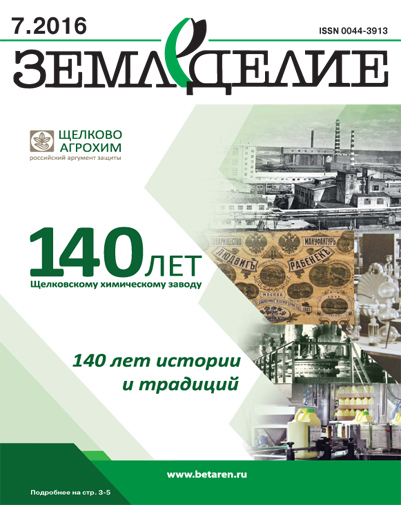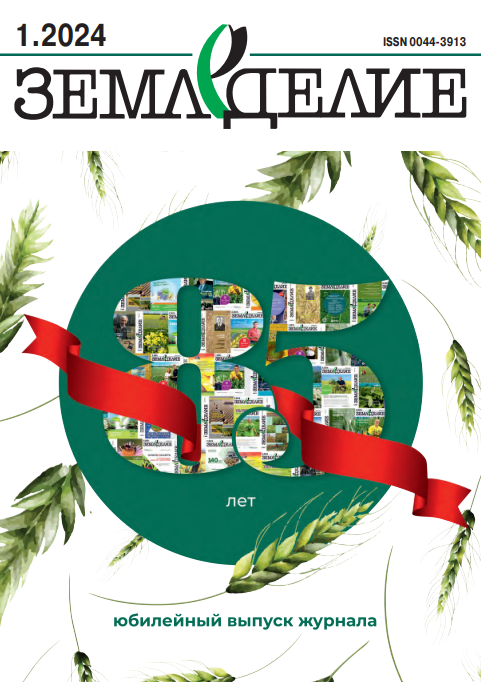Продуктивность и экономическая эффективность зернопарового севооборота в Кулундинской степи в зависимости от агротехнологий
Земледелие, 2016, № 7
УДК 631.51:633.853.78
В.П. ОЛЕШКО, доктор сельскохозяйственных наук, зам. директора
Адрес электронной почты защищен от спам-ботов. Для просмотра адреса в вашем браузере должен быть включен Javascript.
А.А. ГАРКУША, кандидат сельскохозяйственных наук, директор
Д.В. ПУРГИН, кандидат сельскохозяйственных наук, зав. лабораторией
В.И. КРАВЧЕНКО, кандидат сельскохозяйственных наук, зав. центром
Алтайский научно-исследо ватель- ский институт сельского хозяйства, Научный городок, 35, Барнаул-51, Алтайский край, 656910, Российская Федерация
Цель исследований – изучение влияния способов обработки почвы и вариантов химизации на продуктивность и экономическую эффективность зернопарового севооборота. Опыт проводили в многолетнем стационаре Кулундинской сельскохозяйственной опытной станции Алтайского НИИСХ на каштановой супесчаной почве с содержанием гумуса 2,4-2,6%. Изучали способы основной обработки почвы (плоскорезная, вспашка, поверхностная и поверхностная с внесением глифосата в паровом поле), а также различные варианты химизации (без удобрений и гербицидов – контроль, баковая смесь гербицидов, баковая смесь гербицидов + N40). Независимо от способа обработки почвы и варианта химизации, по мере удаления культур от пара засоренность посевов возрастает. Минимизация обработки почвы способствует не только увеличению общей засоренности, но и возрастанию доли злакового компонента, что ведет к росту затрат на контроль сорняков. На легких по гранулометрическому составу почвах Кулундинской степи способы обработки существенно не влияют на урожайность культур севооборота – различия между этими вариантами в среднем по опыту не превышали 0,1 т/га и находились в пределах ошибки. Наибольшую продуктивность севооборота, независимо от фона обработки, обеспечивает комплексное применение гербицидов и удобрений. Использование этого приема повышало выход зерна с 1 га севооборотной площади на 0,30-0,36 т/га, или 40,5-55,4%. По мере роста уровня химизации затраты относительно контроля возрастали в 1,9-2,5 раза, что опережало увеличение продуктивности севооборота. Поэтому окупаемость затрат с улучшением агрофона снижалась на 28,0-41,1%.
Ключевые слова: способ обработки почвы, уровень химизации, севооборот, засоренность, урожайность, экономическая эффективность.
Для цитирования: Продуктивность и экономическая эффективность зернопарового севооборота в Кулундинской степи в зависимости от агротехнологий / В.П. Олешко, А.А. Гаркуша, Д.В. Пургин, В.И. Кравченко // Земледелие. 2016. №7. С. 27-30.
Productivity and Economic Efficiency of Grain-Fallow Crop Rotation in Kulunda Steppe Depending on Agricultural Technologies
V.P. Oleshko, A.A. Garkusha, D.V. Purgin, V.I. Kravchenko
Altai Research Institute of Agriculture, Nauchnyi gorodok, 35, Barnaul- 51, Altayskii kray, 656910, Russian Federation
The aim of the research was to study the influence of tillage and application of chemicals on productivity and economic efficiency of grain-fallow crop rotation. The investigations were conducted in the long-term stationary experiment of Kulunda Agricultural Experiment Station of the Altai Research Institute of Agriculture on chestnut sandy loam soil with humus content of 2.4-2.6%. We studied the methods of main tillage (subsurface cultivation, plowing, surface tillage and surface tillage with an application of glyphosate in the fallow field) and different variants of chemicals application (without herbicides and fertilizers (control), tank mixture of herbicides, tank mixture of herbicides + N40). The results of the studies revealed that regardless of the method of tillage and chemicalization variant the infestation of crops was the greater, the more time past after the fallow field. Minimizing of tillage contributes not only to the increase in the total infestation but also to the growth of the fraction of the cereal weeds, leading to increased costs for weed control. On lighttextured soils of the Kulunda steppe the ways of soil processing have no significant effect on yield of crops, the differences between the processing backgrounds on the average over the test did not exceed 0.1 t/ha and were within the limits of error. The maximum productivity of the crop rotation, regardless of the background of soil processing, is provided by the comprehensive application of herbicides and fertilizers. The use of this method increased the yield of grain from 1 ha of crop rotation area, depending on the way of soil processing, by 0.30-0.36 t/ha or 40.5-55.4%. With the growth of the level of chemicals application the costs were increased relative to controls 1.9-2.5 times, i.e. they significantly surpassed the increase in the productivity of crop rotation. Therefore, the return on investment with the improvement of soil fertility decreased by 28.0-41.1%.
Keywords: way of soil processing, level of chemicals application, crop rotation, infestation, yield, economic efficiency.
Author Details: V.P. Oleshko, D. Sc. (Agr.), deputy director (e-mail: aniish@mail. ru); A.A. Garkusha, Cand. Sc. (Agr.), director; D.V. Purgin, Cand. Sc. (Agr.), head of laboratory; V.I. Kravchenko, Cand. Sc. (Agr.), head of steppe agriculture centre.
For citation: Oleshko V.P., Garkusha A.A., Purgin D.V., Kravchenko V.I. Productivity and Economic Efficiency of Grain-Fallow Crop Rotation in Kulunda Steppe Depending on Agricultural Technologies // Zemledelie. 2016. No. 7. Pp. 27-30 (in Russ.).










